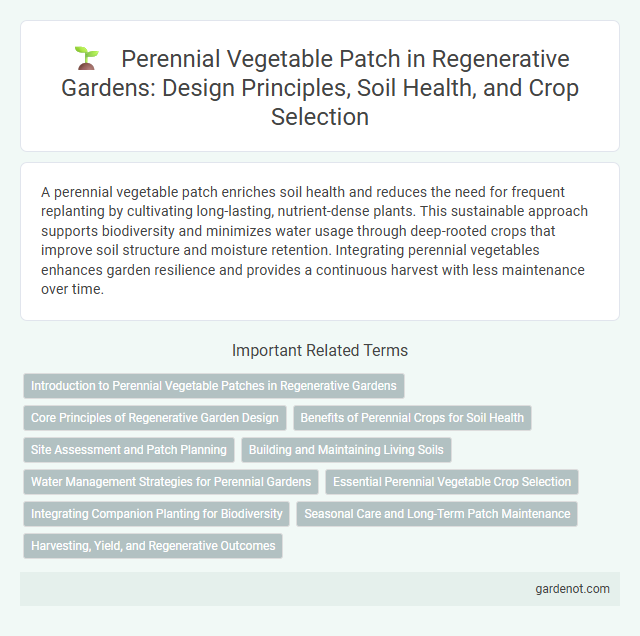A perennial vegetable patch enriches soil health and reduces the need for frequent replanting by cultivating long-lasting, nutrient-dense plants. This sustainable approach supports biodiversity and minimizes water usage through deep-rooted crops that improve soil structure and moisture retention. Integrating perennial vegetables enhances garden resilience and provides a continuous harvest with less maintenance over time.
Introduction to Perennial Vegetable Patches in Regenerative Gardens
Perennial vegetable patches enhance regenerative gardens by providing sustainable, low-maintenance food sources that improve soil health and biodiversity. These patches include crops like asparagus, rhubarb, and kale, which grow year after year without replanting, reducing soil disturbance and erosion. Integrating perennial vegetables supports carbon sequestration, conserves water, and fosters resilient ecosystems within agroforestry and permaculture systems.
Core Principles of Regenerative Garden Design
A perennial vegetable patch maximizes soil health by promoting biodiversity and enhancing nutrient cycling through deep-rooted plants that reduce erosion and increase organic matter. Integrating companion planting and polycultures supports natural pest control and optimizes space efficiency, aligning with regenerative garden principles. This design emphasizes minimal soil disturbance and water retention techniques to sustain long-term ecosystem resilience and productivity.
Benefits of Perennial Crops for Soil Health
Perennial vegetable patches significantly enhance soil health by maintaining continuous ground cover, which reduces erosion and improves moisture retention. Their deep root systems increase soil aeration and promote nutrient cycling, enriching the soil with organic matter over time. These crops also support diverse microbial communities, fostering a resilient and sustainable garden ecosystem.
Site Assessment and Patch Planning
Site assessment for a perennial vegetable patch involves analyzing soil quality, sunlight exposure, drainage, and microclimates to ensure optimal plant growth. Detailed patch planning includes selecting suitable perennial vegetables based on local climate, soil conditions, and intended harvest cycles to maximize yield and sustainability. Integrating permaculture principles and companion planting boosts biodiversity and supports long-term soil health in the regenerative garden.
Building and Maintaining Living Soils
Building and maintaining living soils in a perennial vegetable patch enhances nutrient cycling and soil biodiversity, supporting robust plant growth year after year. Incorporating organic matter such as compost and mulch increases microbial activity, improves soil structure, and retains moisture, creating a resilient ecosystem for perennial crops. Regularly rotating companion plants and minimizing soil disturbance preserve soil health and promote sustainable harvests in regenerative garden systems.
Water Management Strategies for Perennial Gardens
Perennial vegetable patches benefit from water management strategies that prioritize soil moisture retention and efficient irrigation techniques such as drip systems and mulching. Implementing swales or contour basins can capture and direct rainwater, minimizing runoff and maximizing water infiltration in the root zones of long-lived plants. Selecting drought-tolerant perennials further reduces water demand while promoting sustainable growth throughout varying seasonal conditions.
Essential Perennial Vegetable Crop Selection
Selecting essential perennial vegetable crops for a regenerative garden emphasizes species like asparagus, kale, and rhubarb, which provide continuous yield with minimal soil disturbance. These crops enhance soil health through deep root systems that promote nutrient cycling and improve microbial activity. Incorporating nitrogen-fixing plants such as perennial peas further supports sustainable growth and reduces the need for synthetic fertilizers.
Integrating Companion Planting for Biodiversity
Creating a perennial vegetable patch with companion planting enhances soil health and pest control by promoting symbiotic relationships between diverse plant species. Integrating nitrogen-fixing legumes like beans with nutrient-demanding crops such as tomatoes boosts nutrient cycling and reduces the need for synthetic fertilizers. This biodiversity-rich approach supports beneficial insects, improves plant resilience, and fosters a sustainable, regenerative garden ecosystem.
Seasonal Care and Long-Term Patch Maintenance
A well-tended perennial vegetable patch thrives through seasonal care practices such as timely pruning, mulching, and soil enrichment with organic matter to support year-round productivity. Monitoring plant health during dormant and growth phases prevents pests and diseases, ensuring robust development over multiple seasons. Implementing crop rotation and periodic soil testing maintains nutrient balance and soil structure, promoting the long-term sustainability of the regenerative garden.
Harvesting, Yield, and Regenerative Outcomes
Perennial vegetable patches provide sustainable, high-yield harvests by continuously producing nutrient-rich crops such as kale, asparagus, and rhubarb with minimal soil disturbance. These gardens improve soil health by enhancing microbial activity and increasing carbon sequestration, promoting long-term fertility and resilience. Optimizing harvesting techniques, like selective pruning and timely gathering, maximizes yield while supporting the regenerative processes essential to ecosystem balance.
Perennial vegetable patch Infographic

 gardenot.com
gardenot.com